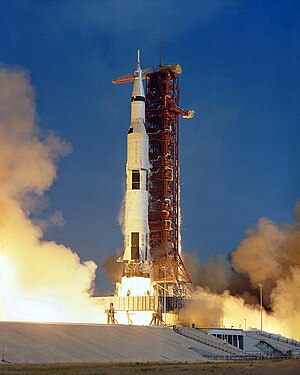Template:POTD/2019-07-16
Appearance
The Saturn V was an American human-rated expendable launch system used by NASA between 1967 and 1973. Developed to support the Apollo program's mission of human exploration of the Moon, the super heavy-lift launch vehicle consisted of liquid-propellant rockets in three stages: the S-IC, the S-II and the S-IVB. The whole vehicle stood 111 m (363 ft) tall when measured together with its Apollo spacecraft payload. The S-IC first stage alone measured 42 m (138 ft) in height and 10 m (33 ft) in diameter, with a total mass at launch of 2.3 million kilograms (5.1 million pounds), consisting mostly of its kerosene-based RP-1 fuel and liquid oxygen used as an oxidizer.
This picture shows the Saturn V SA-506 carrying Apollo 11, the first crewed lunar landing mission, launching from the Kennedy Space Center's Launch Pad 39A on July 16, 1969, at 13:32 UTC. The S-IC engines ignited a few seconds before liftoff and continued to fire until 2 minutes and 42 seconds into flight. The first stage provided more than 34,000 kN (7,600,000 lbf) of thrust, generated by five Rocketdyne F-1 engines arrayed in a quincunx, with a fixed center engine and four outer engines that gimballed for steering.Photograph credit: NASA; retouched by PawełMM

